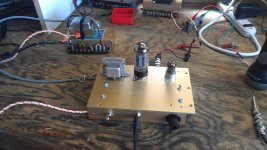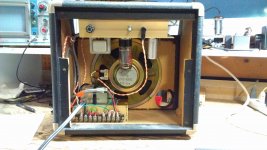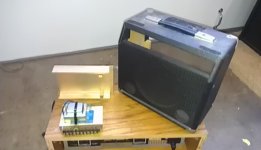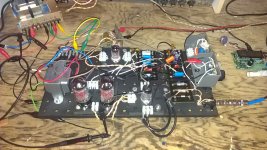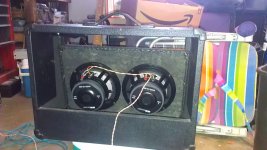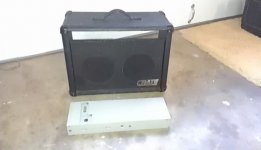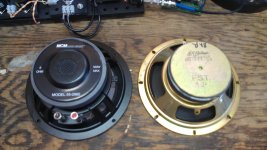JM, I was that kid once a long time ago...I remember well what you are talking about.
Maybe we can help the kids who have got one of these, and maybe they would like to ''upgrade'' it at a reasonable cost if they don't have a lot of money to buy into a better amp..I am not worried at all about Fender surviving in the entry amp market (they have enough high end products and their brand name to support it).
So I did not buy the Frontman 25R amp (at least for now) because I don't need to have their logo stuck on a practice amp. What I am in process of doing is design-build of a retrograde amp board . This will be the opposite of an ''upgrade''. Start with less features, focus on tone and build from there. Can use the cabinet/transfo/chassis and knobs of the donor amp (Fender or other practice amp orphan, or scratch build it. Scavenge the chip amp form the donor or e-buy a TDA board to keep the kid's costs down.
If a kid can upgrade a speaker, and swap a board for a reasonable cost, maybe it is worth it to him or her. People install computer board upgrades all the time, so just imagining this should not be too difficult.
Maybe we can help the kids who have got one of these, and maybe they would like to ''upgrade'' it at a reasonable cost if they don't have a lot of money to buy into a better amp..I am not worried at all about Fender surviving in the entry amp market (they have enough high end products and their brand name to support it).
So I did not buy the Frontman 25R amp (at least for now) because I don't need to have their logo stuck on a practice amp. What I am in process of doing is design-build of a retrograde amp board . This will be the opposite of an ''upgrade''. Start with less features, focus on tone and build from there. Can use the cabinet/transfo/chassis and knobs of the donor amp (Fender or other practice amp orphan, or scratch build it. Scavenge the chip amp form the donor or e-buy a TDA board to keep the kid's costs down.
If a kid can upgrade a speaker, and swap a board for a reasonable cost, maybe it is worth it to him or her. People install computer board upgrades all the time, so just imagining this should not be too difficult.
Some considerations
So far I have been looking at speaker response curves, and attempting to simplify , reduce parts count and keep costs reasonable.
First things first, deciding on the filtering and tone controls is based on the speaker you have. The factory stock speaker seems to be an Achilles heal, whereby much circuit compensation needed to be added to get a reasonable guitar amp response out of a speaker that could also ''somewhat'' handle the full audio band for the RCA jacks. That's sort of the general idea.
But if you have done a speaker upgrade there may be some extra good news in that. You can start out with a simpler tone control.🙂
Early Champs and Princeton often use a single knob tone circuit. The mid scoop was coming from the speaker. Jensen speakers had their typical response which lent to the early fender sound. When they changed over to speakers which were flatter in the mids so the tone controls were redesigned to scoop out more middle. So if you have an Eminence speaker with a flatter mid, then a later design tone stack may be more appropriate.
To reduce parts count further I am doing a simpler preamp, which doesn't switch the extra distortion/filtering stages in. ''Warm Clean'' to overdrive by the same circuit stages. Milder overdrive yes, but preserving more guitar tone. The overdrive switching is replaced by a boost switch.
So far I have been looking at speaker response curves, and attempting to simplify , reduce parts count and keep costs reasonable.
First things first, deciding on the filtering and tone controls is based on the speaker you have. The factory stock speaker seems to be an Achilles heal, whereby much circuit compensation needed to be added to get a reasonable guitar amp response out of a speaker that could also ''somewhat'' handle the full audio band for the RCA jacks. That's sort of the general idea.
But if you have done a speaker upgrade there may be some extra good news in that. You can start out with a simpler tone control.🙂
Early Champs and Princeton often use a single knob tone circuit. The mid scoop was coming from the speaker. Jensen speakers had their typical response which lent to the early fender sound. When they changed over to speakers which were flatter in the mids so the tone controls were redesigned to scoop out more middle. So if you have an Eminence speaker with a flatter mid, then a later design tone stack may be more appropriate.
To reduce parts count further I am doing a simpler preamp, which doesn't switch the extra distortion/filtering stages in. ''Warm Clean'' to overdrive by the same circuit stages. Milder overdrive yes, but preserving more guitar tone. The overdrive switching is replaced by a boost switch.
I agree the quickest way to improve the sound on a budget is a better speaker (and bigger if possible - 8" for 6", 10" for 8"), and a couple of stomp boxes for overdrive and effects. Adding the original reverb option will be a disappointment. Or, you can gut the cab and throw a 5F1 into it. I did it to a Squire (oh, and I did replace the Fender spkr...).
Attachments
Hi LA, I had checked out your build thread and was amazed you got it to fit in(!) excellent work. What speaker did you end up going with?
Yes everything was tight, and with me placing the 6V6 in the middle (for "symmetry") it was 1/4" away from the stock speaker! So I relocated the tube socket, and put in a 4 ohm from a Crate GX-40D cab (also shown) - which was a stereo chorus amp. It's getting a 5E3 Deluxe stuffed into it, with two 8 ohm MCM speakers. I's doing all this on the cheap, but still learning a lot. Only been into tubes for 1-1/2 yrs.... The amp drives a 2x12 cab nicely, so will have an ext jack so it will work for low-vol practicing, jamming, and maybe small stage use (with an external cab).
Attachments
Very cool LA. I am still working on this stuff, and once I get some things tweaked will post some pics etc.. Need to do some chassis drilling but my garage space is too cold at moment.
good speaker match?
OK maybe this is just a little too obvious. If you have an entry level SS amp, notice that there is also a rather large amount of ''entry to mid level'' tube amps out there. Now,those people are also upgrading their speakers to higher level stuff, however those stock speakers they are unloading are rather nice buy for a 15 W Solid State amp upgrade. Look up : ''Fender Eminence Speaker'' on e-buy. Maybe you will get something for, say, $45 in really good shape. Does it sound good? Well, yes indeedy IMHO. (I am running some tests through a Blues Jr stock speaker rated 50W).
What you are looking for is value, and perceived value of factory stock speakers is low for someone who is ''upgrading'' to webers, greenbacks, patriots or whatevers on their tube amp. But this is a big payoff for someone who picks them up cheap to upgrade an entry level amp.
Hope this helps, and more to follow...
OK maybe this is just a little too obvious. If you have an entry level SS amp, notice that there is also a rather large amount of ''entry to mid level'' tube amps out there. Now,those people are also upgrading their speakers to higher level stuff, however those stock speakers they are unloading are rather nice buy for a 15 W Solid State amp upgrade. Look up : ''Fender Eminence Speaker'' on e-buy. Maybe you will get something for, say, $45 in really good shape. Does it sound good? Well, yes indeedy IMHO. (I am running some tests through a Blues Jr stock speaker rated 50W).
What you are looking for is value, and perceived value of factory stock speakers is low for someone who is ''upgrading'' to webers, greenbacks, patriots or whatevers on their tube amp. But this is a big payoff for someone who picks them up cheap to upgrade an entry level amp.
Hope this helps, and more to follow...
Agree. You may find those speakers locally at Craigslist or garage sales for as low as $10 to $25, depending on how "garbage" the seller "thinks" they are.
Of course, you know otherwise.
Or you can buy excellent NEW Jensen MOD speakers for around $40 .
Killer speakers.
Of course, you know otherwise.
Or you can buy excellent NEW Jensen MOD speakers for around $40 .
Killer speakers.
Hi JM, Right on about that. Could you compare the mod series with say a C10R or a C12R ''small magnet'' ceramic? I am now comparing the Fender stock Eminence (Blues Jr 50W rated big magnet) with a reconed C12R (25W) from 1967. To my ears, as I bring up the volume from zero, the lower wattage C12R sound comes alive much earlier (maybe less than 1W). The 50W Eminence starts to hit its stride at guessing 3 or 4 W, is more ''forward'' mid tone.
I am running a TDA 2030 chip amp at 14W max and the C12R just nails the mid 60's Fender tone. The C12R that I have is a special 4 ohm, I can't remember which amp companies were using these in '67. The new Jensen ''vintage ceramics'' are also very reasonable about $50 or $60.
So I guess choosing between various speakers comes down to tonal preference and matching speaker wattage to power amp watts. I really like the 25W rated speaker for a 10 to 15 W amp..especially at very low volume setting. The 50W rated speaker cone travel at very low power settings sounds a bit brittle and weak, but if you run it at 4 to 10 Watts it's really good. On a 25W rated amp, the big magnet speakers would be perfect.
I am running a TDA 2030 chip amp at 14W max and the C12R just nails the mid 60's Fender tone. The C12R that I have is a special 4 ohm, I can't remember which amp companies were using these in '67. The new Jensen ''vintage ceramics'' are also very reasonable about $50 or $60.
So I guess choosing between various speakers comes down to tonal preference and matching speaker wattage to power amp watts. I really like the 25W rated speaker for a 10 to 15 W amp..especially at very low volume setting. The 50W rated speaker cone travel at very low power settings sounds a bit brittle and weak, but if you run it at 4 to 10 Watts it's really good. On a 25W rated amp, the big magnet speakers would be perfect.
Basically Mod 10(12)35 *is* a Jensen C10(12)R but it stands 10 xtra watts and is slightly less bright, both matching traits indicate a slightly heavier voice coil, probably Kapton instead of paper or Nomex , or something they call Epotex (EPOxy TEXtile???) instead of Kapton.
Also MOD designers can use whatever they want, within budget, while "Jensen" must adhere to the Jensen Recipe, which among other things often calls for obsolete seamed cones and probvably old solvent based adhesives instead of Epoxy.
There are also big magnet MOD speakers.
MOD 70 is the Bugera choice for Heavy Metal punch and sturdiness in 2 x 12" combos or 4x12" , and MOD110 is killer in LOUD single 12" combos.
Also MOD designers can use whatever they want, within budget, while "Jensen" must adhere to the Jensen Recipe, which among other things often calls for obsolete seamed cones and probvably old solvent based adhesives instead of Epoxy.
There are also big magnet MOD speakers.
MOD 70 is the Bugera choice for Heavy Metal punch and sturdiness in 2 x 12" combos or 4x12" , and MOD110 is killer in LOUD single 12" combos.
So I think that, budget wise we know that $40 or so can buy into a serious pro-music speaker, if one is careful. Looking at the rest of the upgrade or ''retro-grade'' amp, I have about $40 to $60 worth of parts into it, at most. Not including the transformer or chassis, I assume those are coming from the donor amp.
Not trying to compare Fender list price or anything, just saying that we try and help some people with the FM series and not overspend(!)
Not trying to compare Fender list price or anything, just saying that we try and help some people with the FM series and not overspend(!)
Less is more
This is my impression but it sounded quite obvious..
From my listening tests, my TDA2030 running only standard voltage NFB etc, and basic Zobel with no fancy speaker correction on preamp or power amp :
With a rather good 4'' audio driver it sounds like playing through a stereo.
With the Jensen C12R, and the Celestion loaded, the thing sounds like a guitar amp.
I know this is really simple, but look at it this way: you upgrade the speaker on these practice amps and all of a sudden a good chunk of the filter circuitry that was need to correct the factory stock speaker response is no longer needed, and is actually getting in the way and coloring your tone badly. It now is correcting something that doesn't need correcting!
Question for engineering diapertment: Why do they have current feedback on power amp for these low-end stock speaker? Do they want to emphasize the rather awful resonant peaks created by them?
I ran the TDA without current feedback for initial tests with a good musical speaker and it sounded very good IMHO , but I will put a switch and adjustable current drive on that NFB loop. If this going to be an amp head, then I could put a switch selector for 4/8 ohm to half the current sensing resistor value. Let you know if that works (or not!)
This is my impression but it sounded quite obvious..
From my listening tests, my TDA2030 running only standard voltage NFB etc, and basic Zobel with no fancy speaker correction on preamp or power amp :
With a rather good 4'' audio driver it sounds like playing through a stereo.
With the Jensen C12R, and the Celestion loaded, the thing sounds like a guitar amp.
I know this is really simple, but look at it this way: you upgrade the speaker on these practice amps and all of a sudden a good chunk of the filter circuitry that was need to correct the factory stock speaker response is no longer needed, and is actually getting in the way and coloring your tone badly. It now is correcting something that doesn't need correcting!
Question for engineering diapertment: Why do they have current feedback on power amp for these low-end stock speaker? Do they want to emphasize the rather awful resonant peaks created by them?
I ran the TDA without current feedback for initial tests with a good musical speaker and it sounded very good IMHO , but I will put a switch and adjustable current drive on that NFB loop. If this going to be an amp head, then I could put a switch selector for 4/8 ohm to half the current sensing resistor value. Let you know if that works (or not!)
You are right.
I remember seeing a schematic where the extension speaker jack also added a new current sensing resistor in parallel with the first one, to keep amp gain/sensitivity the same.
I remember seeing a schematic where the extension speaker jack also added a new current sensing resistor in parallel with the first one, to keep amp gain/sensitivity the same.
I'm new to this thread. I have a 15B. I have schematics for the 15G and 15B but only know basic electronics. Could someone please tell me whether the 15B can be modded to act like a 15G, where to start and level of difficulty?
Thanks.
Thanks.
In the old days (think '80s and earlier), often the Bass and the Guitar versions of an amp, even large 100W ones, were the same preamp and power amp, with the guitar one having extra reverb and tremolo.
They sometimes used the same PCB , simply unneeded parts were not fit in the Bass version, so if you had the schematic, reasonable building skills and got the same reverb tank (other parts were generic) you could turn one into the other.
Now that still happens in reverb/not reverb versions of starter guitar amps (such as in 15G/15R) but the Bass versions have drifted away.
But Bass amps usually are good for guitar, they just not distort (or distort *very* little) and of course have no effects.
You can easily solve the distortion problem with a good pedal, your choice.
*If* you wish, post both schematics for us to compare, although I suspect they are quite different, except, maybe, the PSU and Power Amp.
They sometimes used the same PCB , simply unneeded parts were not fit in the Bass version, so if you had the schematic, reasonable building skills and got the same reverb tank (other parts were generic) you could turn one into the other.
Now that still happens in reverb/not reverb versions of starter guitar amps (such as in 15G/15R) but the Bass versions have drifted away.
But Bass amps usually are good for guitar, they just not distort (or distort *very* little) and of course have no effects.
You can easily solve the distortion problem with a good pedal, your choice.
*If* you wish, post both schematics for us to compare, although I suspect they are quite different, except, maybe, the PSU and Power Amp.
Thanks Fahey! I wasn't thinking of adding any effects such as reverb. In my simple mind I was thinking perhaps it was as simple as replacing a few resistors and/or capacitors. (Told you I don't know much!)
Any, I've attached both schematics in case it is straight forward.
Any, I've attached both schematics in case it is straight forward.
Attachments
Preamp, Chip Amp and speaker
Just an update on my build and tests. I physically divided the amp sections onto separate boards. This was better for me to experiment, and I think that if someone wants to re-work an existing low cost practice amp it will be simpler to build and test section by section. Have a look at the section of chip amps in DIY Audio, and you will find excellent reference material, pictures of very good quality built amps .
My power amp is a TDA chip amp ''kit PCB'' and there are a few on the market which are around $15 for single channel with all components. The board was of good quality with plated through holes and I just modified so it could accept the current feedback, but it is not absolutely necessary to run with current NFB. I could have easily built it point to point on perfboard, but wanted to see what the quality of components would come with a ''low cost'' kit. They were adequate, but I think I'll replace with higher filter cap ratings on the electrolytics , a couple of film caps in place of ceramics and bigger heatsink.
The power supply board (rectifier diodes and 2200 uF / 63V filter cap) is perfboard and hard wired up . That is about $3 to $5. Or free (we like free in DIY!) if you pull the components from existing boards or junk parts bin. I am running 30Vdc to the power amp for about 14W into 4 Ohms. This is more than loud enough for a practice amp with the 12'' speaker.
The preamp board is built, it's ''old style'' point to point hardwired. 3 gain stages -3 discreet transistors in Class A. It's got a pre-gain adjust pot on first stage (with pull-to-boost switch), a volume pot, and single tone control (which I am in process of tweaking). I have some wiring to clean up but all is working well. Budget cost about $15 to $20 tops.
I can overdrive the gain stages very easily with the pull to boost switch, and get very nice overall response.
Just an update on my build and tests. I physically divided the amp sections onto separate boards. This was better for me to experiment, and I think that if someone wants to re-work an existing low cost practice amp it will be simpler to build and test section by section. Have a look at the section of chip amps in DIY Audio, and you will find excellent reference material, pictures of very good quality built amps .
My power amp is a TDA chip amp ''kit PCB'' and there are a few on the market which are around $15 for single channel with all components. The board was of good quality with plated through holes and I just modified so it could accept the current feedback, but it is not absolutely necessary to run with current NFB. I could have easily built it point to point on perfboard, but wanted to see what the quality of components would come with a ''low cost'' kit. They were adequate, but I think I'll replace with higher filter cap ratings on the electrolytics , a couple of film caps in place of ceramics and bigger heatsink.
The power supply board (rectifier diodes and 2200 uF / 63V filter cap) is perfboard and hard wired up . That is about $3 to $5. Or free (we like free in DIY!) if you pull the components from existing boards or junk parts bin. I am running 30Vdc to the power amp for about 14W into 4 Ohms. This is more than loud enough for a practice amp with the 12'' speaker.
The preamp board is built, it's ''old style'' point to point hardwired. 3 gain stages -3 discreet transistors in Class A. It's got a pre-gain adjust pot on first stage (with pull-to-boost switch), a volume pot, and single tone control (which I am in process of tweaking). I have some wiring to clean up but all is working well. Budget cost about $15 to $20 tops.
I can overdrive the gain stages very easily with the pull to boost switch, and get very nice overall response.
I am planning to do one other board with LFO for tremelo circuit, and a reverb unit driver. Not including the reverb tank and RCA cables, the ''effects board'' should cost no more than $15.
If I can pick up a tank off of a blues Jr that somebody is ''upgrading'' on theirs, maybe it's about 15-25 dollars. That tank will drive off of an TL072 op amp, the tank input is high impedance enough.
If I can pick up a tank off of a blues Jr that somebody is ''upgrading'' on theirs, maybe it's about 15-25 dollars. That tank will drive off of an TL072 op amp, the tank input is high impedance enough.
Frontman 25R
I have a Frontman 25R that recently died because of my own doing. The chassis and and 10" speaker (stock replaced with Eminence Ragin' Cajun) are perfectly good.
I've been contemplating gutting the internals and replacing it with the power section from Rod Elliott's Project 27 and a pre-amp of my own design. I believe the chassis in the 25R is well suited to house the heatsink and AC power transformer (toroidal of course) required.
I have the ESP Power AMP PCB on hand, and just need to get around to initiating this project.
The power section is well designed, with current feedback and low damping factor to emulate the transformer in a traditional tube guitar amp. The output transistors also employ large emitter resistors for soft clipping. It would be interesting to compare this solid state design to one of my tube amps, tonally.
Reverb can easily be replaced by something like the Belton BTDR Digital Reverb brick.
I have a Frontman 25R that recently died because of my own doing. The chassis and and 10" speaker (stock replaced with Eminence Ragin' Cajun) are perfectly good.
I've been contemplating gutting the internals and replacing it with the power section from Rod Elliott's Project 27 and a pre-amp of my own design. I believe the chassis in the 25R is well suited to house the heatsink and AC power transformer (toroidal of course) required.
I have the ESP Power AMP PCB on hand, and just need to get around to initiating this project.
The power section is well designed, with current feedback and low damping factor to emulate the transformer in a traditional tube guitar amp. The output transistors also employ large emitter resistors for soft clipping. It would be interesting to compare this solid state design to one of my tube amps, tonally.
Reverb can easily be replaced by something like the Belton BTDR Digital Reverb brick.
- Status
- Not open for further replies.
- Home
- Live Sound
- Instruments and Amps
- Modding a Fender Frontman 15G?

